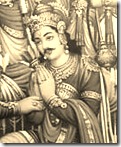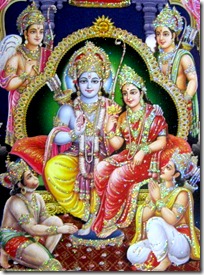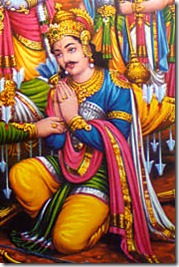 “The human being is the elder brother of all other living beings. He is endowed with intelligence more powerful than animals for realizing the course of nature and the indications of the Almighty Father.” (Shrila Prabhupada, Shrimad Bhagavatam, 1.10.4 Purport)
“The human being is the elder brother of all other living beings. He is endowed with intelligence more powerful than animals for realizing the course of nature and the indications of the Almighty Father.” (Shrila Prabhupada, Shrimad Bhagavatam, 1.10.4 Purport)
It’s just not fair. The elder brother gets all the grief, all the negative attention, and seemingly none of the benefits. The younger siblings can mess up all the time, perform poorly, set a bad example for others, and still not get nearly as much blame as the eldest child does. This is a fact of life that must eventually be accepted, for the older one is supposed to be wiser. They are expected to set a good example for the rest of the children to follow. The elder brother has the authority as well, for they are more powerful than the younger brothers until full maturity is reached. With that responsibility comes the potential for setting the best example and also providing the best protection. The elder brother who fulfills their obligations thus achieves a very high end in life.
Why does the eldest get this burden? What if they didn’t ask for it? The younger ones live under the protection of the parents and the elder brother. The protection of the parents is easy to understand. The mother and father provide for the food, clothing and shelter and make sure that the difficulties in life are minimized while the young ones have a chance to mature. The protection of the elder brother comes in the form of the shielding of the parents’ influence. In the majority of cases, the younger siblings can skate by without drawing too much attention to themselves, but the elder is not so lucky. They are the first ones to get the blame and the last ones to get the credit. Nevertheless, throughout the course of human history there have been some terrific elder brothers, who bore the responsibility without uttering a complaint and set the best example for future generations.
 Of course a brother who is an incarnation of God would serve as the ideal example. Shri Ramachandra, also known as Lord Rama, the eldest son of Maharaja Dasharatha, set a terrific example for His younger brothers to follow. Sometimes the right course in life wasn’t apparently clear and Rama was not without His own difficult circumstances. As the eldest son, Rama was expected to be the successor to the throne, but on the eve of His coronation, He was instead ordered to leave the kingdom. Here was an instance where Rama was wronged without a reason. He was treated unfairly only because of the selfish motives of one of Dasharatha’s wives, Kaikeyi, who wanted her own son Bharata to be on the throne.
Of course a brother who is an incarnation of God would serve as the ideal example. Shri Ramachandra, also known as Lord Rama, the eldest son of Maharaja Dasharatha, set a terrific example for His younger brothers to follow. Sometimes the right course in life wasn’t apparently clear and Rama was not without His own difficult circumstances. As the eldest son, Rama was expected to be the successor to the throne, but on the eve of His coronation, He was instead ordered to leave the kingdom. Here was an instance where Rama was wronged without a reason. He was treated unfairly only because of the selfish motives of one of Dasharatha’s wives, Kaikeyi, who wanted her own son Bharata to be on the throne.“Please tell me which of Your enemies shall today be deprived of their life, fame, and friends by me. I am Your faithful servant, so please do instruct me as to how I shall go about bringing this whole earth under Your control.” (Lakshmana speaking to Lord Rama, Valmiki Ramayana, Ayodhya Kand, 23.40)
Lord Rama was the most powerful bow warrior of His time, so He could put up a violent resistance at any time. Indeed, this is what the younger brother Lakshmana suggested. Lakshmana was the third of four sons of Dasharatha, and he was the closest to Rama, though all the brothers respected and loved their eldest brother. Rama took the news of exile to the forest for fourteen years in stride, but Lakshmana did not. He did not have an example to set. Rather, he was able to follow his natural inclination of loving Rama first, without giving much attention to other details.
Lakshmana loved Rama more than anyone else, and he showed this by suggesting that the Lord enact a coup and take over the kingdom. Lest Rama think He would have to do all the work, Lakshmana insisted that he would administer the violent overthrow all by himself. Should Dasharatha or Bharata mount an opposition, Lakshmana would defeat them in battle. Rama was certainly pleased to the heart by the devotion shown by Lakshmana, but the suggestion was never taken seriously. Dasharatha and Bharata had done nothing wrong, and if Rama ignored the order, it would sully the family name established by the many pious kings who previously ruled in the Ikshvaku dynasty.
Rama set the example of an ideal elder brother and righteous ruler. He was detached from the outcome of events, though He fought rigorously to defend dharma, or religiosity. His brothers didn’t bear nearly the same burden because they were not the eldest in the family, but they appreciated everything that Rama did for them. Bharata, for his part, would later try to convince Rama to return home from the forest, but the Lord responded with many cogent facts relating to the shastras, or scriptures, and the need for upholding the good name of the father.
 Many thousands of years later, an incarnation of dharma itself, Maharaja Yudhishthira, set a great example for his four younger brothers. The Pandavas faced many hardships and it would have been easy to ignore the rules of propriety and simply go on the attack against the aggressors in this case, the Kauravas. Bhima, one of the younger brothers, was always in an irritated spirit, angry at the people who had wronged his family. If not for Yudhishthira’s calming influence, Bhima might have acted upon his inclination towards violence. The eldest brother had much pressure on him, and sometimes he buckled under that pressure, but never did he completely abandon virtue. Rather, he was there every step of the way to set the best example, which would eventually result in the triumph of the Pandavas over the Kauravas. Of course that victory was not without the aid of the same Shri Rama in His original form of Lord Krishna, the Supreme Personality of Godhead.
Many thousands of years later, an incarnation of dharma itself, Maharaja Yudhishthira, set a great example for his four younger brothers. The Pandavas faced many hardships and it would have been easy to ignore the rules of propriety and simply go on the attack against the aggressors in this case, the Kauravas. Bhima, one of the younger brothers, was always in an irritated spirit, angry at the people who had wronged his family. If not for Yudhishthira’s calming influence, Bhima might have acted upon his inclination towards violence. The eldest brother had much pressure on him, and sometimes he buckled under that pressure, but never did he completely abandon virtue. Rather, he was there every step of the way to set the best example, which would eventually result in the triumph of the Pandavas over the Kauravas. Of course that victory was not without the aid of the same Shri Rama in His original form of Lord Krishna, the Supreme Personality of Godhead.
In the bigger picture, the human being is considered the elder brother of all living entities. Strange to think that we have a relation to tigers, alligators and insects, but we do. Every life force is a part and parcel of the Supreme Lord, miniature samples of God that are vastly inferior in the output of divine qualities. Knowledge, wealth, beauty, fame, strength and renunciation exist in the human being but not nearly to the same levels as they are found in the Supreme Lord.
The variety in species exists because of guna and karma, or inherent qualities and fruitive action. Yet just because one person makes a mistake and another is free of mistakes doesn’t mean that there is any constitutional difference between the two. The results are just temporary, while the qualitative makeup is the same. In the same light, the lower species are either travelling upward in the chain of spiritual evolution towards the highest form known as the human birth or they have temporarily fallen down from the auspicious condition of the human life.
In either case the human being still bears the burden of responsibility, for they are more intelligent. If the younger brother and older brother should get into a fight, even if the older is not in the wrong, the parents will blame him. “But Dad, I didn’t start it. He hit me first.” What is the response of the parents? “Well, you’re supposed to know better. He doesn’t know what he is doing, but you do.” For the human being this same principle applies. Just because the tiger eats other animals doesn’t mean that the mature human being has to follow the same behavior. Rather, with the combination of sobriety in thought and activity in the mode of goodness, the human being has the chance to realize the oneness of spirit, to see the undivided in the divided.
“That knowledge by which one undivided spiritual nature is seen in all existences, undivided in the divided, is knowledge in the mode of goodness.” (Lord Krishna, Bhagavad-gita, 18.20)
 Not that everyone is the exact same entity or God Himself, but every living being is part of the giant collection of spiritual energy known as Brahman. Only the human being can realize Brahman, and from that realization comes model behavior, which seeks to maintain that equal vision and also advance to the next position of loving God in His personal form. The living entity must eat another living entity to survive, for that is the law of nature. At the same time, however, there is discrimination. Even amongst meat eaters, there isn’t a desire to eat other human beings or cats or dogs. Therefore, the human being naturally uses discrimination, and with the vision of Brahman, the right kind of discrimination is applied.
Not that everyone is the exact same entity or God Himself, but every living being is part of the giant collection of spiritual energy known as Brahman. Only the human being can realize Brahman, and from that realization comes model behavior, which seeks to maintain that equal vision and also advance to the next position of loving God in His personal form. The living entity must eat another living entity to survive, for that is the law of nature. At the same time, however, there is discrimination. Even amongst meat eaters, there isn’t a desire to eat other human beings or cats or dogs. Therefore, the human being naturally uses discrimination, and with the vision of Brahman, the right kind of discrimination is applied.“If one offers Me with love and devotion a leaf, a flower, fruit, or water, I will accept it.” (Lord Krishna, Bg. 9.26)
How do we know which living entities we are allowed to eat? Grains, fruits, vegetables and milk have been provided to the human being for its sustenance. There is no sin involved in eating these foodstuffs when they have been first offered to the Supreme Lord. Animal flesh cannot be offered to the Supreme Personality of Godhead, for He has no desire to profit from another creature’s unlawful slaying. The food consumption of the human should also be limited, as eating is not meant solely to fulfill urges for sense gratification. It is correct to try to maintain the vital force within the body, for as long as there is conscious thought within the human form there is every chance of realizing God. But to try to go beyond maintaining the body and enjoy the senses at the cost of others is not a valid utilization of effort.
From setting the best example through loving God, the human being automatically has love for other creatures. With love for everyone, there is no question of anger, rage, greed, vengeance, or unnecessarily inhibiting the growth of others. Thus simply by loving God, by regularly chanting His names, “Hare Krishna Hare Krishna, Krishna Krishna, Hare Hare, Hare Rama Hare Rama, Rama Rama, Hare Hare”, the elder brother that is the human being sets up conditions where everyone can move forward in their evolution towards the same platform of God consciousness.
In Closing:
The elder brother sets example on how to live,
Proper knowledge to younger siblings he gives.
In quarrel, spotlight on elder all the same,
Even if younger started, elder still to get blame.
Human being is elder of species, should set good example,
By knowing that all living entities of God are a sample.
Tigers and other creatures their prey they will chase,
Wiser human their behavior not to imitate.
Grains, flowers and milk for human being’s palate,
By devotion to God, in pure goodness sit.
